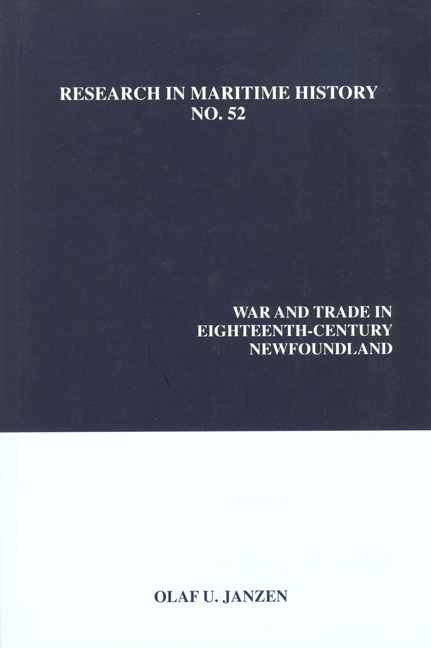Book contents
- Frontmatter
- Table of Contents
- About the Author
- Introduction
- “‘A World Embracing Sea:’ The Oceans as Highway, 1604-1815”
- “Of Consequence to the Service:' The Rationale behind Cartographic Surveys in Early Eighteenth-Century Newfoundland”
- “The Problem of Piracy in the Newfoundland Fishery in the Aftermath of the War of the Spanish Succession”
- “A Scottish Sack Ship in the Newfoundland Trade, 1726-1727”
- “'Une petite Republique' in Southwestern Newfoundland: The Limits of Imperial Authority in a Remote Maritime Environment”
- “The Illicit Trade in English Cod into Spain, 1739-1748”
- “Un Petit Dérangement: The Eviction of French Fishermen from Newfoundland in 1755”
- “The French Raid upon the Newfoundland Fishery in 1762: A Study in the Nature and Limits of Eighteenth-Century Sea Power”
- “Showing the Flag: Hugh Palliser in Western Newfoundland, 1763-1766”
- “The Royal Navy and the Interdiction of Aboriginal Migration to Newfoundland, 1763-1766”
- “The Royal Navy and the Defence of Newfoundland during the American Revolution”
- “The American Threat to the Newfoundland Fisheries, 1776-1777”
- Appendix
“Showing the Flag: Hugh Palliser in Western Newfoundland, 1763-1766”
- Frontmatter
- Table of Contents
- About the Author
- Introduction
- “‘A World Embracing Sea:’ The Oceans as Highway, 1604-1815”
- “Of Consequence to the Service:' The Rationale behind Cartographic Surveys in Early Eighteenth-Century Newfoundland”
- “The Problem of Piracy in the Newfoundland Fishery in the Aftermath of the War of the Spanish Succession”
- “A Scottish Sack Ship in the Newfoundland Trade, 1726-1727”
- “'Une petite Republique' in Southwestern Newfoundland: The Limits of Imperial Authority in a Remote Maritime Environment”
- “The Illicit Trade in English Cod into Spain, 1739-1748”
- “Un Petit Dérangement: The Eviction of French Fishermen from Newfoundland in 1755”
- “The French Raid upon the Newfoundland Fishery in 1762: A Study in the Nature and Limits of Eighteenth-Century Sea Power”
- “Showing the Flag: Hugh Palliser in Western Newfoundland, 1763-1766”
- “The Royal Navy and the Interdiction of Aboriginal Migration to Newfoundland, 1763-1766”
- “The Royal Navy and the Defence of Newfoundland during the American Revolution”
- “The American Threat to the Newfoundland Fisheries, 1776-1777”
- Appendix
Summary
In the summer of 1764, something rather remarkable occurred in the Bay of Islands on the western coast of Newfoundland. The bay had long been a favourite destination of Breton fishing vessels from Saint-Malo and Basque craft from Saint-Jean-de-Luz and Bayonne. Technically, they should not have been there at all: ever since France signed the Treaty of Utrecht in 1713, its fishermen were prohibited from fishing except on the so-called “French” or “Treaty Shore” to the north. But the fishing grounds in western Newfoundland were rich and productive, and the Bay of Islands had all the ingredients necessary to maintain seasonal shore stations. Best of all, despite its claims of sovereignty, the region was devoid of English patrols. British warships stationed at Newfoundland were virtually unknown north of Bonavista or west beyond Placentia. Western Newfoundland was hardly known to them at all before 1763 when Lark under Captain Samuel Thompson appeared and remained on station throughout the summer. For the prescient, Lark's visit was the shape of things to come; late in July 1764, not one but three British warships sailed into the Bay of Islands, shortly to be joined by a fourth. Even more remarkable, the squadron was under the command of Captain Hugh Palliser, commander in chief of the Newfoundland station and civil governor of the island. Never before had a governor ventured more than a couple of days’ sail from St. John's. There could be no mistake about the message that Palliser was delivering: England was no longer indifferent to its claim to Newfoundland beyond the Avalon Peninsula. It was a message only the Royal Navy could have delivered.
During the eighteenth century, both France and England held the migratory fishery at Newfoundland in the highest regard. In the conventional wisdom of the age, it was a “nursery for seamen,” not only employing thousands of landsmen every year but also transforming them into experienced mariners who were then available for service in their national navies in the event of war. This made it a strategic asset of the first order. In terms of direct employment, consumption of domestic goods and services and the generation of a favourable balance of trade with other mercantile powers, the fishery was a source of great national wealth and, by extension in a mercantile age, of great national power.
- Type
- Chapter
- Information
- War and Trade in Eighteenth-Century Newfoundland , pp. 155 - 172Publisher: Liverpool University PressPrint publication year: 2013



